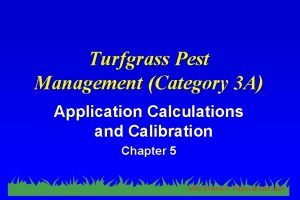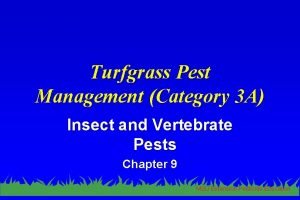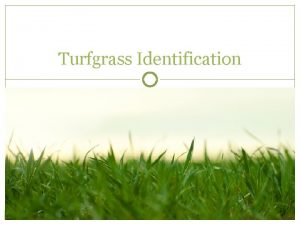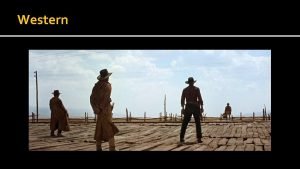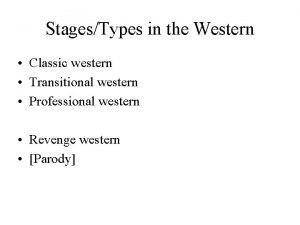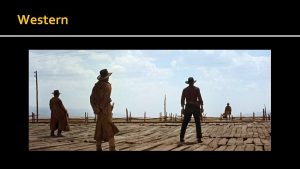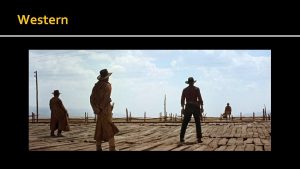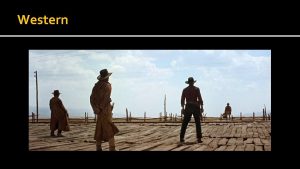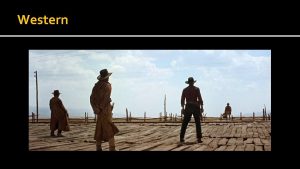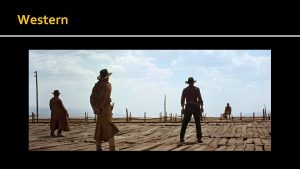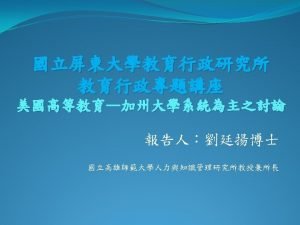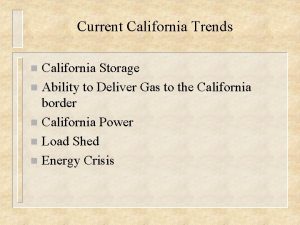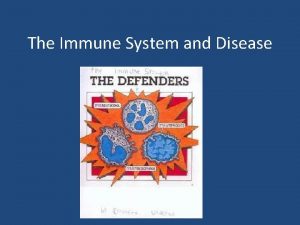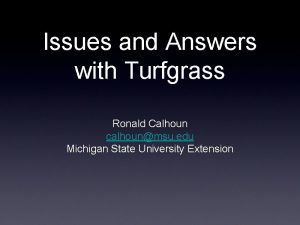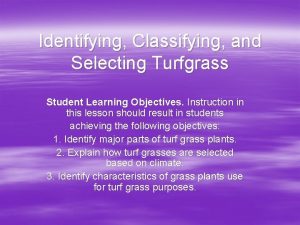Turfgrass Disease Trends in California and the Western






















- Slides: 22

Turfgrass Disease Trends in California and the Western United States Naveen Hyder & Frank Wong Department of Plant Pathology & Microbiology University of California, Riverside

Background information q California has the largest turf and landscape industry in the US (approx. 15 billion) q Approx. 950 golf courses in the state of California – 2 nd in the US q Not much information available due to lack of turfgrass pathology program since the 1990 s

Objective q To assess turfgrass disease trends in California and the Western United States based on diagnostic laboratory data ØWhat are the major disease problems? ØWhat are the major hosts? ØWhat are the disease trends over the last four years? ØWhere should research efforts be focused?

Materials and methods q A sample = 1 cup cutter size plug of plants and soil q For this study 1 data point = one pathogen/plant interaction q Data based on diagnostic samples received Ø Samples are not evenly distributed throughout the Western United States Ø Multiple samples from the same location Ø Data collected from 2006 -2009 (present)

Collecting a data point q Microscopic signs >>> incubate up to 24 -48 hrs q Isolation from tissue Ø Leaves, roots and crown on pathogen specific media

Turf Management for Golf Courses 2001 J. Beard

Common turfgrass species used in California and the Western U. S. q. Cool Season (C 3 Photosynthesis) q. Warm Season (C 4 Photosynthesis) ØPoa annua ØCynodon spp. ØPoa trivialis ØPennisetum ØAgrostis stolonifera clandestinum ØPaspalum vaginatum ØStenotaphrum secundatum ØFestuca arundinacea ØFestuca rubra ØLolium perenne

Geographic origin (based on # of samples received) 2006 2007 2008 2009 Arizona 7 2 1 13 California 389 Colorado 1 3 1 11 Hawaii 4 6 6 5 Idaho 3 1 6 7 Nevada 23 Oregon 7 14 11 9 Texas 2 1 0 3 Utah 1 3 3 2 Washington 20 (85%) (4%) n = 460 366 40 17 (80%) (9%) (4%) n = 457 235 28 12 (77%) (9%) (4%) n = 306 402 25 31 (79%) (5%) (6%) n = 512

Sources of samples (based on number of samples received) 2006 2007 2008 2009 Residential/ commercial landscape 8 7 15 15 Sports turf 11 11 7 18 438 (95%) 439 (96%) 283 (92%) 477 (93%) 3 - 1 2 n = 460 n = 457 n = 306 n = 512 Golf courses Sod farms

Most common turfgrass hosts Data based on n= 3, 360 diagnosis

Poa annua (Annual bluegrass) diseases trends Top 5 from 2006 to 2009 2006 (442) * 2007 (425) * 2008 (471) * 2009 (358) * Algae (17%) Rapid Blight (11%) Anthracnose (14% ) Anthracnose (18%) Summer Patch (15%) Anthracnose (11%) Rapid Blight (13%) Rapid Blight (8%) Rapid Blight (9%) Summer Patch (9%) Algae (12%) Algae (8%) Brown Ring Patch (9%) Summer Patch (8%) Anthracnose (8%) Algae (6%) Brown Ring Patch (5%) Michrodochium Patch (6%) * Total annual bluegrass samples processed Algae (Cyanobacteria) Anthracnose Brown Ring Patch Rapid Blight Summer Patch Michrodochium Patch = Oscillatoria spp. = Colletotrichum cereale = Waitea circinata var. circinata = Labyrinthula terrestris = Magnaporthe poae = Michrodochium nivale



Agrostis stolonifera (Creeping bentgrass) disease trends Top 5 from 2006 -2009 2006 (263) * 2007 (201) * 2008 (185) * 2009 (187) * Algae (24%) Take-All Patch (23%) Algae (10%) Anthracnose (18%) Take-All Patch (21%) Algae (10%) Take-All Patch (14%) Fairy Ring (5%) Anthracnose (6%) Algae (11%) Anthracnose (5%) Fairy Ring (4%) Pythium Blight (5%) Fairy Ring (6%) Pythium Blight (3%) Rhizoctonia Brown Patch (4%) Rhizoctonia Brown Patch (5%) * Total creeping bentgrass samples processed Algae (Cynobacteria) Anthracnose Fairy Ring Pythium Blight Rhizoctonia Brown Patch Take-All Patch = Oscillatoria spp. = Colletotrichum cereale = Various Basidiomycete spp. = Pythium spp. = Rhizoctonia solani = Gaeumannomyces graminis var. avenae


Lolium perenne (Ryegrass) disease trends Top 3 from 2006 - 2009 2006 (173)* 2007 (106)* 2008 (61)* 2009 (67)* Bipolaris Leaf Spot (15%) Brown Patch (21%) Brown Patch (18%) Anthracnose (39%) Brown Patch (15%) Curvularia Blight (17%) Anthracnose (16%) Brown Patch (15%) Curvularia Blight (14%) Bipolaris Leaf Spot (15%) Summer Patch (7%) Bipolaris Leaf Spot (9%) *Total ryegrass samples processed Anthracnose Bipolaris Leaf Spot Brown Patch Curvularia Blight Summer Patch = Colletotrichum cereale = Bipolaris spp. = Rhizoctonia solani = Curvularia spp. = Magnaporthe poae

Cynodon spp. (bermudagrass) disease trends Top 3 from 2006 - 2009 2006 (65)* 2007 (21)* 2008 (45)* 2009 (79)* Spring Dead Spot (23%) Rhizoctonia Large Patch (38%) Bermudagrass Decline (29%) Bermudagrass Decline (35%) Bipolaris Leaf Spot (22%) Spring Dead Spot (28%) Spring Dead Spot (10%) Bermudagrass Decline (17%) Bipolaris Leaf Spot (14%) * Total Bermudagrass samples processed Spring Dead Spot = Ophiosphaerella narmari / O. korrae Bipolaris Leaf Spot = Bipolaris spp. Bermudagrass Decline = Gaeumannomyces graminis var. graminis Rhizoctonia Large Patch = Rhizoctonia solani Bipolaris Leaf Spot (10%)

Pennisetum clandestinum (kikuyugrass) disease trends Top 3 from 2006 - 2009 2006 (28)* 2007 (18)* 2008 (23)* 2009 (14)* Gray Leaf Spot (38%) Kikuyugrass Decline (44%) Rhizoctonia Large Patch (43%) Kikuyugrass Decline (21%) Gray Leaf Spot (16%) Rhizoctonia Large Patch (22%) Kikuyugrass Decline (36%) Rhizoctonia Large Patch (18%) Rhizoctonia Large Patch (16%) Gray Leaf Spot (13%) *Total Kikuyugrass samples processed Gray Leaf Spot = Pyricularia grisea Kikuyugrass Decline = Gaeumannomyces graminis var. graminis Rhizoctonia Large Patch = Rhizoctonia solani AG 2 -2

Summary Total # of samples received (2006 -2009) = 3, 360 94 % of the samples received are from golf courses 90% of these samples from golf course greens Cool season grasses comprise 85% of the samples 50% of these samples are annual bluegrass # 1 problem on annual bluegrass is Anthracnose

Conclusions q First effort to summarize data pertaining to turfgrass diseases in the Western United States q California has a unique turfgrass disease profile because of diversity of climate zones within the state q Top research priority should be cool season turf management esp. diseases of annual bluegrass

Future research scope q Use the data base to: Ø Compare and contrast information with other regions Ø Correlate disease trends with climatic variations Ø Correlate disease trends with agronomic practices specific to California

Acknowledgements Ø GCSAA Environmental Institute of Golf Ø California State GCSAs Ø Syngenta Professional Products Ø Bayer Environmental Sciences
 Turfgrass pest management (category 3a practice test)
Turfgrass pest management (category 3a practice test) Black turfgrass ataenius
Black turfgrass ataenius Turfgrass pest management
Turfgrass pest management Bharathi viswanathan
Bharathi viswanathan Hình ảnh bộ gõ cơ thể búng tay
Hình ảnh bộ gõ cơ thể búng tay Bổ thể
Bổ thể Tỉ lệ cơ thể trẻ em
Tỉ lệ cơ thể trẻ em Gấu đi như thế nào
Gấu đi như thế nào Tư thế worm breton là gì
Tư thế worm breton là gì Chúa yêu trần thế
Chúa yêu trần thế Các môn thể thao bắt đầu bằng tiếng đua
Các môn thể thao bắt đầu bằng tiếng đua Thế nào là hệ số cao nhất
Thế nào là hệ số cao nhất Các châu lục và đại dương trên thế giới
Các châu lục và đại dương trên thế giới Công của trọng lực
Công của trọng lực Trời xanh đây là của chúng ta thể thơ
Trời xanh đây là của chúng ta thể thơ Mật thư anh em như thể tay chân
Mật thư anh em như thể tay chân 101012 bằng
101012 bằng độ dài liên kết
độ dài liên kết Các châu lục và đại dương trên thế giới
Các châu lục và đại dương trên thế giới Thơ thất ngôn tứ tuyệt đường luật
Thơ thất ngôn tứ tuyệt đường luật Quá trình desamine hóa có thể tạo ra
Quá trình desamine hóa có thể tạo ra Một số thể thơ truyền thống
Một số thể thơ truyền thống
